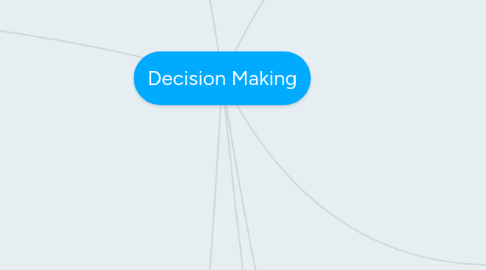
1. Rational decision making process
1.1. Defining the problem
1.1.1. Problem identification : detection and determination of the problem
1.1.2. Problem analysis
1.2. Devising of alternatives
1.3. Evaluation of alternatives
1.3.1. Criteria have to be drawn up.
1.3.1.1. The criteria must be measurabel
1.3.1.2. The criteria must be feasible
1.3.1.3. The criteria must fit the problem.
1.3.1.4. The criteria must complement each othe
1.3.1.5. The criteria must relate to all aspects of the alternative
1.3.2. The likely consequences of each alternative have to be assessed.
1.4. Making a choice
1.4.1. If one of the options satisfies the criteria perfectly, this alternative should be chosen.
1.4.2. If no alternative completely satisfies the criteria, either new alternatives have to be found, or the criteria have to be adjusted.
1.4.3. If two or more alternatives produce the same result. further research is necessary.
1.5. Information is collected during the course of process and analysed
1.5.1. It has to be relevant
1.5.2. It has to be reliable
1.5.3. It has to be available on time
1.5.4. lts costs should be in proportion to its value
1.5.5. It should be presented in a way that makes it easily viewed
2. The decision making process
2.1. Two differents problems
2.1.1. Daily
2.1.2. Vital for the continuity of the organisation
2.2. Making a choice
2.3. Importance of cooperation and creativity
2.4. The factor that complicate decision-making
2.4.1. Value judgements
2.4.2. Joint decision-making
2.4.3. Interdisciplinary input
2.4.4. Long-term consequences
2.4.5. Risk and uncertainty
2.4.6. Intangible factor
2.4.7. A multiplicity of criteria
2.5. Ways to make better decisions
2.5.1. Think as an outside observer
2.5.2. Stay in the present and cut the losses.
2.5.3. Think in another language
2.5.4. Cultivate the emotional intelligence
2.5.5. Consider the environment
2.5.6. Take a moment before making your decision
3. To hone skills in making decisions
3.1. Create multiple options
3.2. Listen patiently
3.3. Weigh the pros and cons
3.4. Rule out indecision
3.5. Distribute power
4. Decision-making in organisations
4.1. Problems and decision making
4.1.1. The character of the problem is
4.1.1.1. Routine
4.1.1.1.1. Pre-programmed process
4.1.1.1.2. Incidental
4.1.1.2. Specific
4.1.1.2.1. Unique
4.1.1.2.2. "once-off" decision
4.1.2. The situation is
4.1.2.1. Urgent
4.1.2.2. Not urgent
4.1.3. Those involved are
4.1.3.1. Individuals
4.1.3.2. Groups
4.2. Decision-making and predictability
4.2.1. Absolute certainty
4.2.2. Partial certainty
4.2.3. Partial uncertainty
4.2.4. Complete uncertainty
5. Irrational decision making processes
5.1. The neo-rational decision-making process
5.1.1. Emotional and intuitive aspects play a role
5.1.2. Informal and centralised
5.2. The bureaucratic decision-making process
5.2.1. Based on fixed rules
5.2.2. Very formal and centralised
5.3. The political decision-making process
5.3.1. Formal and decentralised
5.3.2. Negotiations and interactions between groups
5.4. The open-ended decision-making process
5.4.1. Informal and decentralised
5.4.2. No clear objectives and decisions. Chance play a large role
6. Decision-making in the European-Union
6.1. Decision-making procedure: 'codecision'
6.2. EU decision making involves three main institution
6.2.1. the European Commission, which represents the interests of the EU as a whole
6.2.2. the Council of the European Union, which represents the individual member countries
6.2.3. the European Parliament, which represents EU citizens and is directly elected by them
7. Approaches
7.1. "Defending"
7.1.1. Resembles a battle of wills, though not always an intentionally engaged in battle.
7.2. "Researching"
7.2.1. An open process, focussed on the exchange of ideas and collective devising of alternatives, leading to a well-considered decision.
